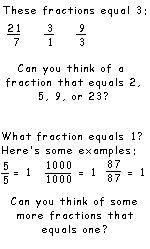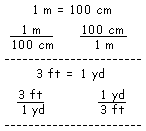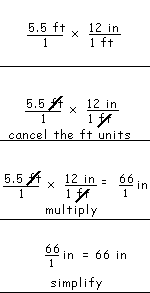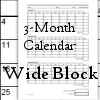| Before I delve into this subject, I want to
review one basic concept that needs to be understood before learning how
to do unit multipliers.
Concept #1: Writing any whole number as a fraction while
still retaining its value:
|
Examples of Concept #1:
|
What Concept #1 has to do with unit
multipliers:
Unit multipliers are fractions that equal 1. The difference between ordinary fractions that equal one and unit multipliers is that unit multipliers require units. What do you mean by units? In the case of unit multipliers, I am referring to units of measure such as feet, inches, millimeters, centimeters,..... all units of measure, linear (length), liquid, mass, weight,...... |
|||||||
|
Now that the formalities are over with, let's look at a unit multiplier... |
|||||||||
| Remember how to make a fraction that equals 1?
Here are a couple of unit multipliers that equals 1:
It is true! Both of the fractions above equals one. Do you see why it equals 1? Here's a clue......
So do you see why it equals 1?
|
Let's look closer.....
So the "units" in unit multipliers are important and completely necessary! Do not leave them out!
|
Here are some more examples of unit
multipliers:
I am thinking that you can make your own unit multipliers now! Below are some equivalence tables that you can use to help you make unit multipliers. |
|||||||
|
Equivalence Table for Units
|
|||||||||
|
Now that you are familiar with unit multipliers, let's talk about how to use them. You will use unit multipliers to convert the unit of a denominate number while still retaining the value of the denominate number. What's a denominate number?? denominate number, pronounced dih NAHM uh niht, tells the amount of a quantity by giving the number of units and the kind of units that make up the quantity. A denominate number includes a number, which may be written as a numeral or as a word, and the name or symbol of a unit of measurement. Six meters, 90 pounds, $500 million, 50 miles, 23 DEG>C, and 4 days are all denominate numbers.
Let's look at how to use unit multipliers.... |
|||||||||
| First of all, let's say that I want
to know how many inches 5.5 feet are. We understand that we
are working with feet and inches.
First, I will change 5.5 feet (a denominate number) into a fraction:
Second, I think about what unit multiplier that I can use to convert feet to inches. I know that 12 inches = 1 foot so the available unit multipliers are:
Which one do I choose? It does make a difference and it is important to choose the right unit multiplier. Fortunately, it's an easy choice. Choose the unit multiplier that has same unit (in this case, feet) in the denominator place. (?) In other words, because feet is the numerator in the fraction: 5.5 feet/1, you should have feet as the denominator in your unit multiplier. We must choose |
Remember... the unit multiplier
equals one. When you multiply a denominate number and a unit multiplier,
the denominate number retains its value because any number that is
multiplied by one stays the same. The change will be with which unit the
value is expressed.
Here's how it is done...
|
||||||||
|
How about a couple of other examples to set this better in your mind... |
|||||||||
| Example #1:
Let's convert 243 feet into yards. 1. Change 243 feet into a fraction. 2. Choose the correct unit multiplier. 3. Cancel out. 4. Multiply. 5. Simplify. The denominate number 243 feet equals the denominate number 81 yards. |
Example #2:
Convert 629 centimeters into meters. 1. Make 629 centimeters a fraction. 2. Choose a unit converter. 3. Cancel out the cm. 4. Multiply. 5. Simplify (already did it)
|
||||||||

You are at DonnaYoung.org, online since 1998. Thank you for visiting my website. Donna Young





 Dated Daily Lesson Planner
Dated Daily Lesson Planner About AOP LifePac Electives Art
About AOP LifePac Electives Art


